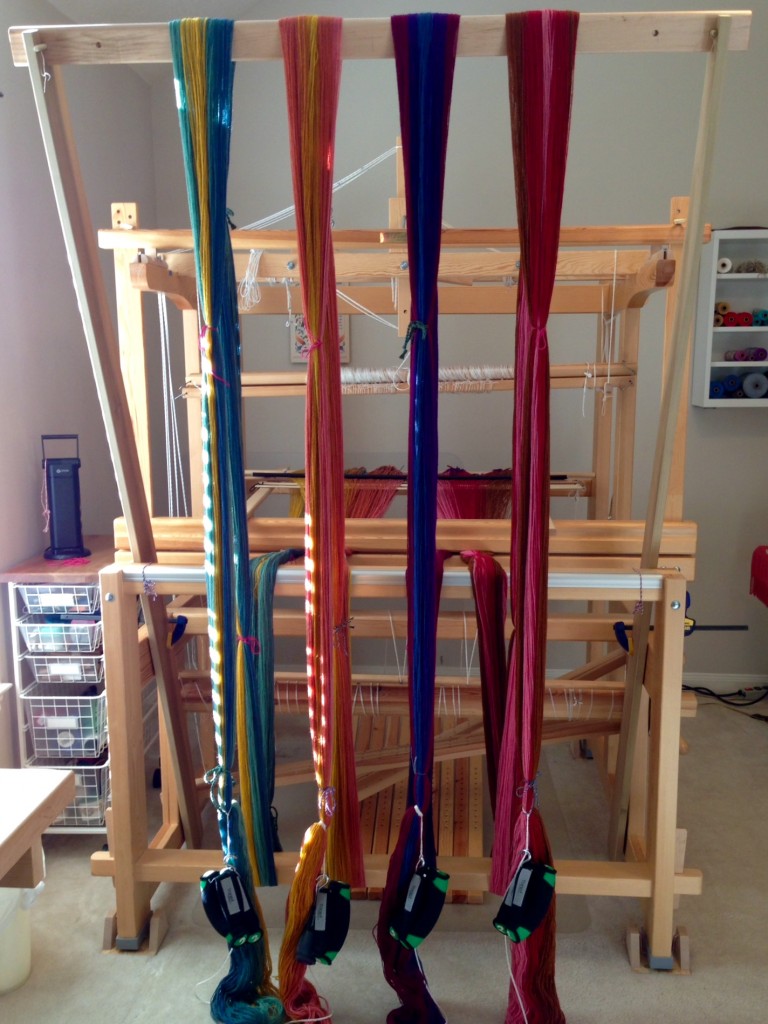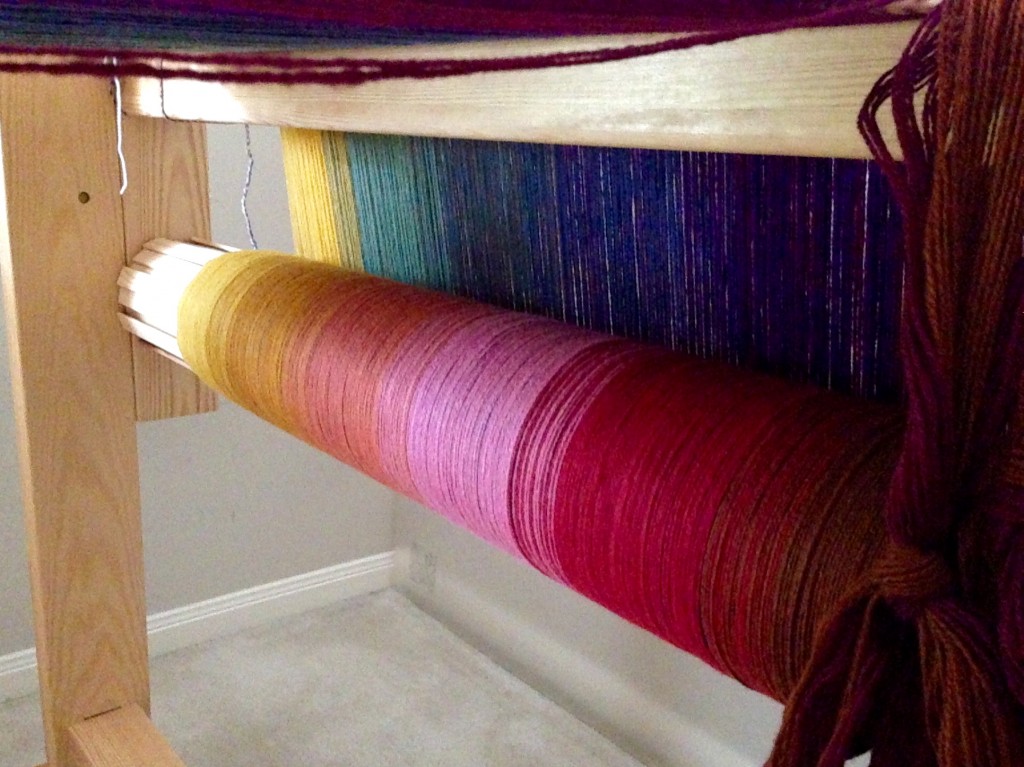This is my first double width attempt, and it makes me nervous. Dressing the loom feels intimidating when you are trying something new. Each layer has its own warp chains and its own set of lease sticks. And eleven colors–will they end up in the correct order? My uncertainty makes me feel like a beginner again.

Stepping through uncertainty takes bravery, and a bit of “Oh well, it is what it is.” Even ordinary weaving is filled with uncertainty. You don’t know if you succeeded in dressing the loom properly until you start weaving. And you don’t totally see how your weaving looks until it comes off the loom. Even then, the fabric has more to reveal when it is wet finished. Weaving is not for cowards.

Doing the next thing with courage does make a difference. It is like that with prayer. When I face a new difficulty, I struggle to know what to pray. I feel like a beginner again. But I keep coming back to this comforting thought: God always listens to the heart as much as to the words. God does not look for a “leader” who prays, he looks for an ordinary person who has faith to hear and obey. This is the person whose prayers reach God’s ears.
May you have courage for the next thing.
Learning,
Karen

I am so intrigued! Can’t wait to see the next step.
Katherine,
I’m as intrigued as you are. I love watching the process unfold – especially when trying a new weave structure.
Thanks for leaving a thoughtful comment!
Karen
Karen am I seeing correctly that your warp is traveling through the beater? That part was not described in your description. If that is the case did you run into any problems with the threads snagging ? Do you routinely do this or only for double weave?
I look forward to each of your postings. You have been given a wonderful gift of creativity for both weaving and words by the Great Creator.
God bless,
Jill On the Oregon Coast
Hi Jill, I love your questions! It shows how observant you are.
In the picture with the trapeze, yes, the warp is traveling through the beater. Not shown in the picture is the next step where I placed the pre-sleyed reed in the beater. Did I run into problems with the threads snagging? Yes and no. Yes – the wool threads want to grip each other, so I had to watch carefully, and wind on very slowly, checking every few inches to make sure nothing was getting hung up. No – no actual problems because I intentionally went slow and took as much time as needed.
This is the only way I am accustomed to warping the loom, from back to front. I didn’t know how well my usual method would work with this double weave warp, but it ended up working just fine.
I appreciate your encouraging words so much! That means a lot to me!
Happy Weaving,
Karen
Hi Karen- I am intrigued with your trapeze set-up. Are you warping front to back going through the beater without a reed? I use a trapeze when warping back to front so I don’t rough sley through a reed. This would maybe be a good subject to pursue some time.
Hi Deb,
Great question! I warp back to front, and I pre-sley (rough sley) through the reed to spread the warp. I have never used a raddle – perhaps that is how you do it?
Point well taken! I will start working on a description of my process of dressing the loom using the warping trapeze. Look for it in a future post.
Happy Warping,
Karen
I’m eager to see how those wonderful colors weave together!
Karen, I’m curious. When you bring the warp around the foot beam, because of the sharper edge on the beam, is there any fraying? And you leave the shafts on while you’re dressing the loom? Thanks for your patience with me.
Hi Karen, the foot beam on my loom has rounded corners, so there are not any sharp edges for the threads to cross. I’ve never had any fraying at all. I think that could be a problem if there were sharp or rough edges, because you are pulling the threads around those corners with a good bit of tension.
I do leave the shafts on the loom, but I raise them up out of the way. And then, I lower the shafts back into place after the warp is beamed.
I love questions! Thank you for asking!
Karen
I just looked at my Standard. The foot beam’s edges are not actually sharp, but they’re not nearly as rounded as the breast beam. I’ll stop worrying.
And, if you’re sure you don’t mind questions, I may talk your ear off!
How many shafts does your loom have? I have 12 and getting a clear shed is a misery. Any hints on adjusting the treadles? I saw online the Vavstuga’s kit with knitting needles. Does it work, do you suppose, to just count out each hole on the texsolv?
Thanks, again,
Karen
If your foot beam is not rough, I don’t think you’ll have a problem. For very fine or delicate threads, you could sand out any rough spots on the foot beam first. My Standard is not very old – less than 3 years, so it hasn’t had a lot of wear and tear yet. My 30-yr-old Ideal does have some wear and tear, but I haven’t had a problem with anything snagging or fraying.
I have 8 shafts on my Standard, and 4 on my Ideal. I have plans to add 2 more to each, eventually.
The Vavstuga tie-up system is fantastic. Whether 4 shafts or 8, I always have perfect sheds on the first try. It’s marking the holes on the tie-up cords that makes the difference. That gives you complete consistency across the treadles. Using the beads and knitting needles makes it fast and easy to do the tie-up, or to change it on a whim. I love tying up the treadles! I couldn’t say that when I was putting those footed pegs into holes under the treadles. LOL. That tie-up system proves Becky Ashenden’s genius to me.
Maybe I should think about writing a post – “Why I Love Tying Up My Countermarch” That should get some attention. Smile.
Karen
I’m stalled once again on the tie-up on the treadles. It may take extra time this once, but I think I’m going to give it a try. I’m already using beads, so at least I’ve got a head start! And here’s hoping that it works for 12 shafts!
Thank you, SO MUCH!
(And I’d love to see that post! Or any you write!)
Karen
Good for you for giving it a try! Let me know how it works out.
I spent the whole day marking and readjusting all of the treadle ties. You’re right. It does make things easy. The other way was like when I was learning to make bread dough. It took lots of trial and error before I knew just how it was supposed to feel for just right bread. This gave me a great starting point! I’m still having some problem with getting a good shed, but not nearly as much and I’m able to weave out the cloth anyway. I just have to readjust occasionally and more often, I just reach out and press the shaft bars back into position before I open that particular shed.
Karen, I love the analogy with bread dough. Yes, it’s a lot like that! There are so many variables and it takes much practice over time to get the “feel” of it. I glad it helped you to mark the treadle ties. At least that’s one variable you don’t have to think about as much.
Happy Weaving!